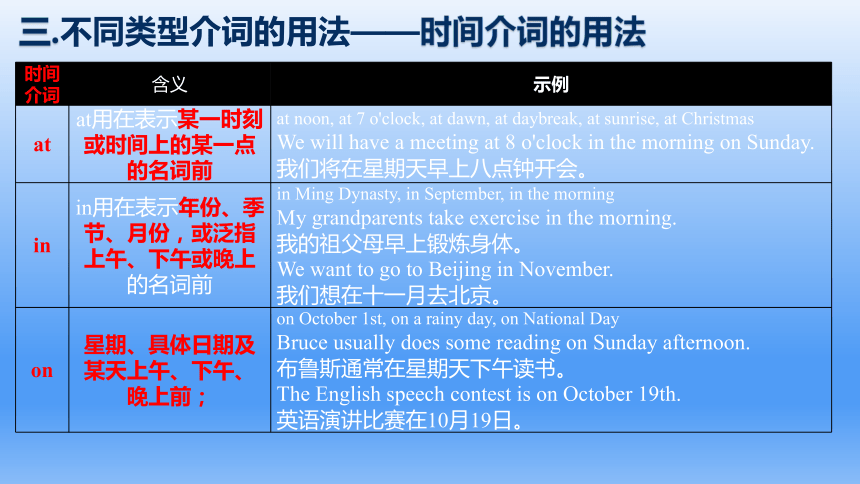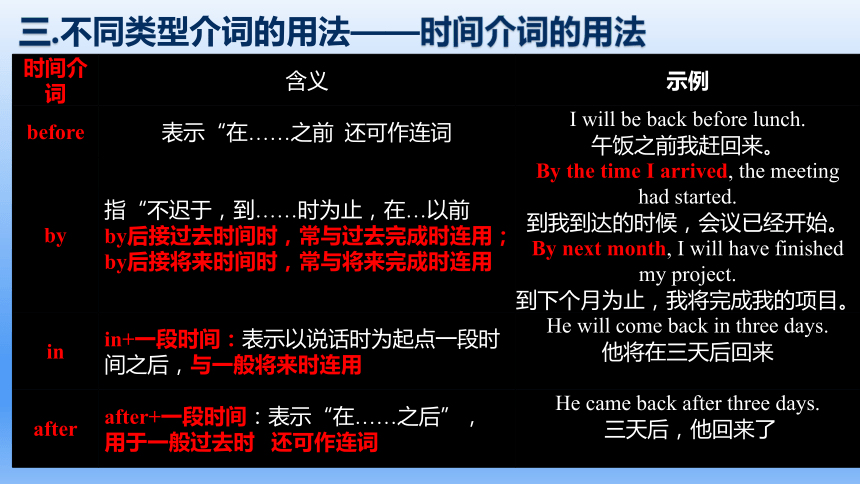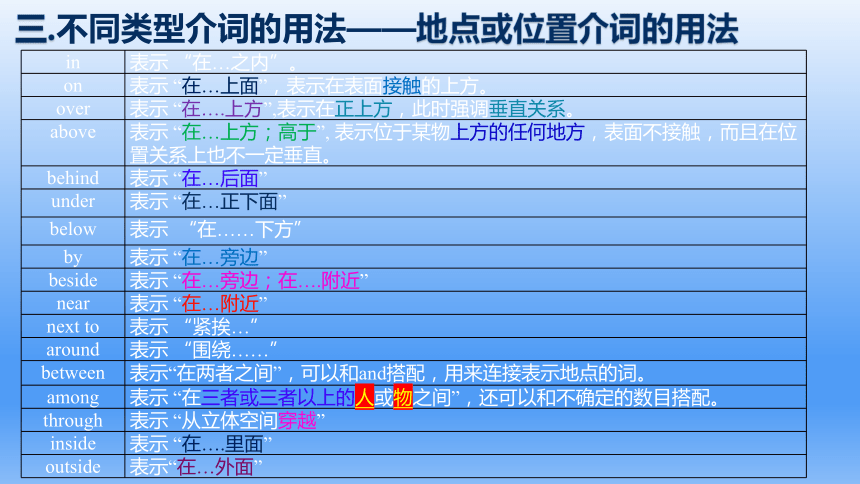2025年高考英语二轮复习专题★★介词 课件(共27张)
文档属性
| 名称 | 2025年高考英语二轮复习专题★★介词 课件(共27张) |  | |
| 格式 | pptx | ||
| 文件大小 | 1.9MB | ||
| 资源类型 | 教案 | ||
| 版本资源 | 通用版 | ||
| 科目 | 英语 | ||
| 更新时间 | 2025-05-09 08:26:52 | ||
图片预览









文档简介
(共27张PPT)
2025年高考英语二轮复习专题★★介词 课件
无提示词
有提示词
介词
冠词
代词
1.谓语动词2.非谓语动词3.动词变其他词性
名词
形容词
副词
语法填空树状图
连词
动词
1.其他词性变名词 2.名词的数 3.名词的所有格
句子成分和句型
1.其他词性变形容词 2.形容词变副词 3.副词修饰动词,形容词,副词和句子。4.形容词,副词的比较级最高级。 5,形容词的反义词
人称代词 反身代词 it用法
不定冠词 定冠词
零冠词的用法
连词:并列连词 but/and/so
从属连词:定语从句/名词性从句/状语从句 (that-which-what…)
考情分析
介词是历年高考常考的知识点。近几年新高考对介词的考查主要集中在语法填空和完形填空,以介词的基本用法和固定搭配为主。
一、介词的定义:
定义:
介词是一种虚词,无词义,不能单独使用,必须用在名词、代词、动名词,或what等引导的宾语从句前面,并与之一起构成介词短语,在句中作表语、定语、状语和补语。
二.介词的基本用法
She smiles at me.
I go to school by bus.
I am interested in studying English.
用法规律:不能单独使用;
后需加上代词/名词/动名词,构成介宾结构。
三.不同类型介词的用法——时间介词的用法
时间介词 含义 示例
at at用在表示某一时刻或时间上的某一点的名词前 at noon, at 7 o'clock, at dawn, at daybreak, at sunrise, at Christmas
We will have a meeting at 8 o'clock in the morning on Sunday.
我们将在星期天早上八点钟开会。
in in用在表示年份、季节、月份,或泛指上午、下午或晚上的名词前 in Ming Dynasty, in September, in the morning
My grandparents take exercise in the morning.
我的祖父母早上锻炼身体。
We want to go to Beijing in November.
我们想在十一月去北京。
on 星期、具体日期及某天上午、下午、晚上前; on October 1st, on a rainy day, on National Day
Bruce usually does some reading on Sunday afternoon.
布鲁斯通常在星期天下午读书。
The English speech contest is on October 19th.
英语演讲比赛在10月19日。
时间介词 含义 示例
for for接时间段,表示某事持续多久,多与完成时连用 My uncle has worked on the farm for ten years.
我叔叔在农场工作了十年。
since since接时间点 “自从……以来” I have been sick since yesterday.
我从昨天起就病了
during “在……期间” I went to France during the summer holiday.
暑假期间我去了法国。
through “一直……,自始至终” They worked hard through the winter.
整个冬天他们都在努力工作。
from 表示时间的起点,意为“从……”,多用于“from...to/中 The meeting will be held from seven to nine.
这个会议将从7点开到9点。
Till/until “直到……为止” You must wait for him till/ until tomorrow.
你必须一直等他到明天。
三.不同类型介词的用法——时间介词的用法
时间介词 含义 示例
before 表示“在……之前 还可作连词 I will be back before lunch.
午饭之前我赶回来。
by 指“不迟于,到……时为止,在…以前 by后接过去时间时,常与过去完成时连用;by后接将来时间时,常与将来完成时连用 By the time I arrived, the meeting had started.
到我到达的时候,会议已经开始。
By next month, I will have finished my project.
到下个月为止,我将完成我的项目。
in in+一段时间:表示以说话时为起点一段时间之后,与一般将来时连用 He will come back in three days.
他将在三天后回来
after after+一段时间:表示“在……之后”, 用于一般过去时 还可作连词 He came back after three days.
三天后,他回来了
三.不同类型介词的用法——时间介词的用法
in 表示 “在…之内”。
on 表示 “在…上面”,表示在表面接触的上方。
over 表示 “在….上方”,表示在正上方,此时强调垂直关系。
above 表示 “在…上方;高于”, 表示位于某物上方的任何地方,表面不接触,而且在位置关系上也不一定垂直。
behind 表示 “在…后面”
under 表示 “在…正下面”
below 表示 “在……下方”
by 表示 “在…旁边”
beside 表示 “在…旁边;在….附近”
near 表示 “在…附近”
next to 表示 “紧挨…”
around 表示 “围绕……”
between 表示“在两者之间”,可以和and搭配,用来连接表示地点的词。
among 表示 “在三者或三者以上的人或物之间”,还可以和不确定的数目搭配。
through 表示 “从立体空间穿越”
inside 表示 “在….里面”
outside 表示“在…外面”
三.不同类型介词的用法——地点或位置介词的用法
三.不同类型介词的用法——地点或位置介词的用法
1、at, in, from
at: 在某处,后通常接相对较小的地点;
They arrived at our school yesterday.
in: 在某处,后通常接相对较大的地点。
Our teachers arrived in Beijing this morning.
from: 指来自某处。
Jane is from the U.S.A.
三.不同类型介词的用法——地点或位置介词的用法
2、in, on, to, off表示两地的位置关系
in: 在某一范围内部 Dalian is in the north of China.
on: 接壤; Hubei is on the north of Hunan.
to: 不在范围内,二者之间有距离间隔,不接壤;
Australia lies to the south of China.
三.不同类型介词的用法——地点或位置介词的用法
3、across, through, over
across:从某物的表面上横过;过河过桥,过马路
Be careful when you walk across the road.
through:从某物的空间内穿过 。过森林,公园
The old man went through the forest.
Over:从上方跨过,翻墙,篱笆等…
The plane flew over the mountains.
三.不同类型介词的用法——地点或位置介词的用法
by, with, in, 都有“以…的方式“之意,区别如下:
by
with
in
by + _________ /___________
交通工具
方式、手段
in+______ / _______/ _______
声音
语言
材料
with+________ / ________
身体器官
具体工具
We remembered them by making word cards. 我们通过制作单词卡片的方式记住了它们。
He goes to school by bike every day. 他每天骑自行车上学。
Jim is climbing the tree with a ladder. 吉姆正在用梯子爬树。
The teacher asked me not to write with a penicl. 老师不让我们用铅笔写字。
She wrote a letter in black ink. 她用黑色的墨水写了一封信。
The novel is written in French. 这部小说是用法语书写的。
注意:on foot 步行
表伴随,意为“随着”
三.不同类型介词的用法——方式介词的用法
四.其他介词
With:和……一起,带着,怀有”;
Mr. Smith has a large house with a swimming pool.
史密斯拥有一间带有游泳池的大房子。
Without:没有,不,无”
He left without saying goodbye. 他没说再见就离开了。
The boy stood there with his head down.
With her parents dead, the girl had to leave school.
The teacher came in with a book in his hand.
With a native our guide, we needn't be afraid to get lost.
With the old man leading the way, we finally found the place.
With his hair cut, he looks much younger.
With Mr. Smith to teach them English, they will be greatly improved next term in spoken English.
四.其他介词
be+of+(great/much)+抽象名词=(very)+形容词,一般作表语。
The meeting is of importance. 会议很重要。
=The meeting is very important.
Your answer is of use.
=Your answer is very useful. 你的答案很有用。
Your advice is of help/benefit.
=Your advice is very helpful/beneficial. 你的建议很有用。
of+no+抽象名词=not+形容词
All our persuasion was of no use; she would not come.
=All our persuasion was not useful; she would not come.
我们所有的劝说都没有用,她不会来的。
四.其他介词
like“像……一样”,含有比喻意味,侧重比较;
Nancy is just like her mother. 南希像她的妈妈。
Spring is like a beautiful girl. 春天就像一个美丽的姑娘。
as“作为……”后接身份、职业、地位等名词。
He is famous as a novelist here. 在这里他作为小说家而出名。
She works as a nurse in the hospital. 她在这家医院当护士。
四.其他介词
about“有关……的内容”(非正式的);
on “关于……的内容”(学术研究方面的)
Lucy told me something about their hometown.
露西告诉我有关他们家乡的一些情况。
There will be a very important report on the present situation.
将有一个关于目前形势的重要讲座。
四.其他介词
of 表所属关系、种类、来源;
I'd like a bottle of orange. (表示种类) 我要一瓶橘子汁。
Two of them are college students. (表示所属关系) 他们中有两个是大学生。
from 表示 “来自 ……”,也可表所属原料。
This is a present from my uncle. (来自)这是我舅舅送的礼物。
Paper is made from wood. (原料)纸是木头做的。(看不出原料)
The bridge is made of stone. (原料)这桥是石头做的。(看得出原料)
四.其他介词
against 表“反对,倚靠”;
She is against the war. 她反对战争。
Don't stand against the door. 不要靠门站着。
for 表“支持,给,供,对于, 为了”。
Are you for the plan?你赞成这个计划吗?
She looks very young for her age. 对她这个年龄来说,她看起来很年轻。
They will raise money for the library. 他们将为建设图书馆筹款。
四. 其他介词
1. beyond 表示“(时间)过了,比……晚,迟于”
They arrived beyond nine o'clock.
他们过了9点才到。
2. beyond表示“(位置)在……的那边,在……以外”
The small village is 20 miles beyond the town.
那个小村庄在离城20英里以外的地方。
3. beyond表示“(范围)超过,为……所不及”
This book is beyond me.
这本书我看不懂。
He is living beyond his income.
他的生活入不敷出。
四.固定搭配
名词 key, approach, solution, answer, entrance, visit, attitude等与介词to构成固定搭配
We have a very communicative approach to teaching languages.
我们有一种非常注重交流的语言教学方法。
We must find a satisfactory solution to the problem.
我们必须找到一个令人满意的解决问题的办法。
考点2 介词的习惯搭配
【要点归纳】
1.与形容词构成的搭配
(1)be+adj.+about
be anxious about 对……忧虑
be curious about 对……好奇
(2)be+adj.+at
be angry at 因……生气
be good at 擅长
(3)be+adj.+in
be absorbed in 专注于
be active in 积极于
be dressed in 穿着
be engaged in 忙于
(4)be+adj.+for
be eager for 渴望
be famous for 因……著名
be fit for 适合,胜任
be ready for 准备好
(5)be+adj.+from
be absent from 缺席
be different from 不同于
(6)be+adj.+to
be close to 接近
be devoted to 致力于
be equal to 等于
be familiar to 对……来说熟悉
(7)be+adj.+of
be aware of 意识到
be fond of 喜欢
(8)be+adj.+with
be busy with 忙于
be familiar with 熟悉
be patient with 对……有耐心
2.与名词构成的搭配
(1)“at+n.”表示状态
at a loss 不知所措
at peace 处于和平状态
at war 在交战状态中
at work 在工作
(2)“on+n.”表示状态
on exhibition/show 在展出
on fire 着火
on sale 出售,打折
on the way 在途中
(3)“by+n.”表示方式
by accident 偶然
by air/plane 乘飞机
by chance 偶然
by design 故意地
(4)“in+n.”表示方式
in cash 用现金付款
in depth 深入地
in detail 详细地
in height 在高度上
(5)“of+n.”表示特征(等于相应的形容词)
of benefit 有益处的
of use 有用的
(6)“out of+n.”表示状态
out of balance 失去平衡
out of breath 上气不接下气
(7)“with+n.”表示方式
with delight/joy 高兴地
with difficulty 困难地
“四种方法”确定介词
(1)根据介词短语与谓语的逻辑关系;
(2)根据语境含义并结合介词用法;
(3)根据特殊的结构关系, 如接复合宾语就只能用with或without;
(4)根据介词与动词、形容词、名词等的搭配。
五、解题思路:
2025年高考英语二轮复习专题★★介词 课件
无提示词
有提示词
介词
冠词
代词
1.谓语动词2.非谓语动词3.动词变其他词性
名词
形容词
副词
语法填空树状图
连词
动词
1.其他词性变名词 2.名词的数 3.名词的所有格
句子成分和句型
1.其他词性变形容词 2.形容词变副词 3.副词修饰动词,形容词,副词和句子。4.形容词,副词的比较级最高级。 5,形容词的反义词
人称代词 反身代词 it用法
不定冠词 定冠词
零冠词的用法
连词:并列连词 but/and/so
从属连词:定语从句/名词性从句/状语从句 (that-which-what…)
考情分析
介词是历年高考常考的知识点。近几年新高考对介词的考查主要集中在语法填空和完形填空,以介词的基本用法和固定搭配为主。
一、介词的定义:
定义:
介词是一种虚词,无词义,不能单独使用,必须用在名词、代词、动名词,或what等引导的宾语从句前面,并与之一起构成介词短语,在句中作表语、定语、状语和补语。
二.介词的基本用法
She smiles at me.
I go to school by bus.
I am interested in studying English.
用法规律:不能单独使用;
后需加上代词/名词/动名词,构成介宾结构。
三.不同类型介词的用法——时间介词的用法
时间介词 含义 示例
at at用在表示某一时刻或时间上的某一点的名词前 at noon, at 7 o'clock, at dawn, at daybreak, at sunrise, at Christmas
We will have a meeting at 8 o'clock in the morning on Sunday.
我们将在星期天早上八点钟开会。
in in用在表示年份、季节、月份,或泛指上午、下午或晚上的名词前 in Ming Dynasty, in September, in the morning
My grandparents take exercise in the morning.
我的祖父母早上锻炼身体。
We want to go to Beijing in November.
我们想在十一月去北京。
on 星期、具体日期及某天上午、下午、晚上前; on October 1st, on a rainy day, on National Day
Bruce usually does some reading on Sunday afternoon.
布鲁斯通常在星期天下午读书。
The English speech contest is on October 19th.
英语演讲比赛在10月19日。
时间介词 含义 示例
for for接时间段,表示某事持续多久,多与完成时连用 My uncle has worked on the farm for ten years.
我叔叔在农场工作了十年。
since since接时间点 “自从……以来” I have been sick since yesterday.
我从昨天起就病了
during “在……期间” I went to France during the summer holiday.
暑假期间我去了法国。
through “一直……,自始至终” They worked hard through the winter.
整个冬天他们都在努力工作。
from 表示时间的起点,意为“从……”,多用于“from...to/中 The meeting will be held from seven to nine.
这个会议将从7点开到9点。
Till/until “直到……为止” You must wait for him till/ until tomorrow.
你必须一直等他到明天。
三.不同类型介词的用法——时间介词的用法
时间介词 含义 示例
before 表示“在……之前 还可作连词 I will be back before lunch.
午饭之前我赶回来。
by 指“不迟于,到……时为止,在…以前 by后接过去时间时,常与过去完成时连用;by后接将来时间时,常与将来完成时连用 By the time I arrived, the meeting had started.
到我到达的时候,会议已经开始。
By next month, I will have finished my project.
到下个月为止,我将完成我的项目。
in in+一段时间:表示以说话时为起点一段时间之后,与一般将来时连用 He will come back in three days.
他将在三天后回来
after after+一段时间:表示“在……之后”, 用于一般过去时 还可作连词 He came back after three days.
三天后,他回来了
三.不同类型介词的用法——时间介词的用法
in 表示 “在…之内”。
on 表示 “在…上面”,表示在表面接触的上方。
over 表示 “在….上方”,表示在正上方,此时强调垂直关系。
above 表示 “在…上方;高于”, 表示位于某物上方的任何地方,表面不接触,而且在位置关系上也不一定垂直。
behind 表示 “在…后面”
under 表示 “在…正下面”
below 表示 “在……下方”
by 表示 “在…旁边”
beside 表示 “在…旁边;在….附近”
near 表示 “在…附近”
next to 表示 “紧挨…”
around 表示 “围绕……”
between 表示“在两者之间”,可以和and搭配,用来连接表示地点的词。
among 表示 “在三者或三者以上的人或物之间”,还可以和不确定的数目搭配。
through 表示 “从立体空间穿越”
inside 表示 “在….里面”
outside 表示“在…外面”
三.不同类型介词的用法——地点或位置介词的用法
三.不同类型介词的用法——地点或位置介词的用法
1、at, in, from
at: 在某处,后通常接相对较小的地点;
They arrived at our school yesterday.
in: 在某处,后通常接相对较大的地点。
Our teachers arrived in Beijing this morning.
from: 指来自某处。
Jane is from the U.S.A.
三.不同类型介词的用法——地点或位置介词的用法
2、in, on, to, off表示两地的位置关系
in: 在某一范围内部 Dalian is in the north of China.
on: 接壤; Hubei is on the north of Hunan.
to: 不在范围内,二者之间有距离间隔,不接壤;
Australia lies to the south of China.
三.不同类型介词的用法——地点或位置介词的用法
3、across, through, over
across:从某物的表面上横过;过河过桥,过马路
Be careful when you walk across the road.
through:从某物的空间内穿过 。过森林,公园
The old man went through the forest.
Over:从上方跨过,翻墙,篱笆等…
The plane flew over the mountains.
三.不同类型介词的用法——地点或位置介词的用法
by, with, in, 都有“以…的方式“之意,区别如下:
by
with
in
by + _________ /___________
交通工具
方式、手段
in+______ / _______/ _______
声音
语言
材料
with+________ / ________
身体器官
具体工具
We remembered them by making word cards. 我们通过制作单词卡片的方式记住了它们。
He goes to school by bike every day. 他每天骑自行车上学。
Jim is climbing the tree with a ladder. 吉姆正在用梯子爬树。
The teacher asked me not to write with a penicl. 老师不让我们用铅笔写字。
She wrote a letter in black ink. 她用黑色的墨水写了一封信。
The novel is written in French. 这部小说是用法语书写的。
注意:on foot 步行
表伴随,意为“随着”
三.不同类型介词的用法——方式介词的用法
四.其他介词
With:和……一起,带着,怀有”;
Mr. Smith has a large house with a swimming pool.
史密斯拥有一间带有游泳池的大房子。
Without:没有,不,无”
He left without saying goodbye. 他没说再见就离开了。
The boy stood there with his head down.
With her parents dead, the girl had to leave school.
The teacher came in with a book in his hand.
With a native our guide, we needn't be afraid to get lost.
With the old man leading the way, we finally found the place.
With his hair cut, he looks much younger.
With Mr. Smith to teach them English, they will be greatly improved next term in spoken English.
四.其他介词
be+of+(great/much)+抽象名词=(very)+形容词,一般作表语。
The meeting is of importance. 会议很重要。
=The meeting is very important.
Your answer is of use.
=Your answer is very useful. 你的答案很有用。
Your advice is of help/benefit.
=Your advice is very helpful/beneficial. 你的建议很有用。
of+no+抽象名词=not+形容词
All our persuasion was of no use; she would not come.
=All our persuasion was not useful; she would not come.
我们所有的劝说都没有用,她不会来的。
四.其他介词
like“像……一样”,含有比喻意味,侧重比较;
Nancy is just like her mother. 南希像她的妈妈。
Spring is like a beautiful girl. 春天就像一个美丽的姑娘。
as“作为……”后接身份、职业、地位等名词。
He is famous as a novelist here. 在这里他作为小说家而出名。
She works as a nurse in the hospital. 她在这家医院当护士。
四.其他介词
about“有关……的内容”(非正式的);
on “关于……的内容”(学术研究方面的)
Lucy told me something about their hometown.
露西告诉我有关他们家乡的一些情况。
There will be a very important report on the present situation.
将有一个关于目前形势的重要讲座。
四.其他介词
of 表所属关系、种类、来源;
I'd like a bottle of orange. (表示种类) 我要一瓶橘子汁。
Two of them are college students. (表示所属关系) 他们中有两个是大学生。
from 表示 “来自 ……”,也可表所属原料。
This is a present from my uncle. (来自)这是我舅舅送的礼物。
Paper is made from wood. (原料)纸是木头做的。(看不出原料)
The bridge is made of stone. (原料)这桥是石头做的。(看得出原料)
四.其他介词
against 表“反对,倚靠”;
She is against the war. 她反对战争。
Don't stand against the door. 不要靠门站着。
for 表“支持,给,供,对于, 为了”。
Are you for the plan?你赞成这个计划吗?
She looks very young for her age. 对她这个年龄来说,她看起来很年轻。
They will raise money for the library. 他们将为建设图书馆筹款。
四. 其他介词
1. beyond 表示“(时间)过了,比……晚,迟于”
They arrived beyond nine o'clock.
他们过了9点才到。
2. beyond表示“(位置)在……的那边,在……以外”
The small village is 20 miles beyond the town.
那个小村庄在离城20英里以外的地方。
3. beyond表示“(范围)超过,为……所不及”
This book is beyond me.
这本书我看不懂。
He is living beyond his income.
他的生活入不敷出。
四.固定搭配
名词 key, approach, solution, answer, entrance, visit, attitude等与介词to构成固定搭配
We have a very communicative approach to teaching languages.
我们有一种非常注重交流的语言教学方法。
We must find a satisfactory solution to the problem.
我们必须找到一个令人满意的解决问题的办法。
考点2 介词的习惯搭配
【要点归纳】
1.与形容词构成的搭配
(1)be+adj.+about
be anxious about 对……忧虑
be curious about 对……好奇
(2)be+adj.+at
be angry at 因……生气
be good at 擅长
(3)be+adj.+in
be absorbed in 专注于
be active in 积极于
be dressed in 穿着
be engaged in 忙于
(4)be+adj.+for
be eager for 渴望
be famous for 因……著名
be fit for 适合,胜任
be ready for 准备好
(5)be+adj.+from
be absent from 缺席
be different from 不同于
(6)be+adj.+to
be close to 接近
be devoted to 致力于
be equal to 等于
be familiar to 对……来说熟悉
(7)be+adj.+of
be aware of 意识到
be fond of 喜欢
(8)be+adj.+with
be busy with 忙于
be familiar with 熟悉
be patient with 对……有耐心
2.与名词构成的搭配
(1)“at+n.”表示状态
at a loss 不知所措
at peace 处于和平状态
at war 在交战状态中
at work 在工作
(2)“on+n.”表示状态
on exhibition/show 在展出
on fire 着火
on sale 出售,打折
on the way 在途中
(3)“by+n.”表示方式
by accident 偶然
by air/plane 乘飞机
by chance 偶然
by design 故意地
(4)“in+n.”表示方式
in cash 用现金付款
in depth 深入地
in detail 详细地
in height 在高度上
(5)“of+n.”表示特征(等于相应的形容词)
of benefit 有益处的
of use 有用的
(6)“out of+n.”表示状态
out of balance 失去平衡
out of breath 上气不接下气
(7)“with+n.”表示方式
with delight/joy 高兴地
with difficulty 困难地
“四种方法”确定介词
(1)根据介词短语与谓语的逻辑关系;
(2)根据语境含义并结合介词用法;
(3)根据特殊的结构关系, 如接复合宾语就只能用with或without;
(4)根据介词与动词、形容词、名词等的搭配。
五、解题思路:
